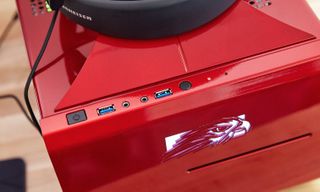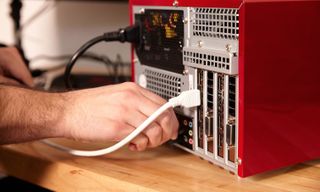Falcon Northwest FragBox Review: $5,000 Worth of Awesome
The Falcon Northwest is a powerful and highly customizable gaming desktop built for the road, if you can splurge.
Why you can trust Tom's Guide

There are plenty of high-end gaming PCs that support monstrous graphics cards and lush paint jobs, but not many of them are made for the road. That's where Falcon Northwest's FragBox comes in. This travel-minded desktop ($2,145 to start, $4,848 as configured) is as portable as it is powerful, thanks to a handy carrying handle and support for the latest Intel Core processors and up to two high-end Nvidia graphics cards. Add in some eye-catching custom paint options, and you've got a premium 4K and VR-ready gaming machine that will look great either in your living room or on the way to your next LAN event.
Design
The Falcon Northwest FragBox is probably the most aptly named PC I've ever reviewed — it's literally a big, travel-friendly rectangular box that packs a ton of high-end gaming power inside. Our model shipped in a shiny coat of cherry-red paint — which, combined with the sleek curve of the system's carrying handle — makes it look like the gaming desktop equivalent of a compact sports car. The glowing, etched-in Falcon logo on the front is a nice extra touch.

As with most Falcon Northwest PCs, you can customize the FragBox to your heart's content. The optional Exotix paintwork gives you a ton of aesthetic options, whether you want a single coat of automotive paint ($375) or you want to douse the PC in flame ($750), rain ($688) or cloud ($938) designs. You can also customize the front Falcon logo, whether you want the default white light or would prefer a gold, silver or copper insert for an extra $13.

One of the FragBox's major selling points is its relative portability, and while the 22-pound machine is pretty hefty, the handle made it fairly easy for me to lug it around the office. At 10.5 x 15.75 x 10 inches, the FragBox is a bit wider and heavier than Lenovo's similarly travel-minded Ideacentre Y710 Cube, but it's also shorter and notably sleeker. Falcon Northwest's PC certainly wouldn't look out of place under or next to your TV — provided you have the shelf space for it.
MORE: The Best Gaming Desktops Available Now
Ports and Upgradability
With two USB 3.0 ports and headphone and mic jacks in the front, the FragBox's essential connections are always within reach.

Turn the machine around, and you'll find four more USB 3.0 ports, a USB 3.1 port, two USB 2.0 ports, an Ethernet jack and a PS/2 port. There's also a USB-C port for newer gadgets, as well as a standard array of audio connections.

Each of the FragBox's Nvidia GeForce GTX 1080 graphics cards sports three DisplayPorts as well as HDMI and VGA connections, making it easy to connect multiple monitors.
It might be small, but the FragBox's mighty graphics muscle is more than strong enough for high-end virtual reality.
The FragBox has some removable screws in the back, but according to Falcon Northwest, this isn't a machine that's necessarily designed for DIY upgrading. Fortunately, you can customize the FragBox to your wildest desires at the point of purchase (more on that later), and the system's three-year parts and labor warranty means that the company will handle any necessary part replacements for you.
Gaming and VR Performance
Our FragBox lived up to its name and then some, with dual Nvidia GeForce GTX 1080 graphics cards that handled games in 4K and VR without a sweat. The PC had no problems with the graphically dense warfare of Battlefield 1 at max settings, running the game at well over 30 frames per second at 4K and upward of 120 fps at 2560 x 1440.

The FragBox earned high marks on our Rise of the Tomb Raider max-settings benchmark, turning in a zippy 91 fps at 1080p and a highly playable 37.95 fps at 4K. That's a bit stronger than our Maingear R1 and its two GTX 1070 cards, which turned in 80 fps at 1080p and 30 fps at 4K.

Falcon's PC was just as impressive while running the slick stealth action of Hitman, blazing through the game's max-settings benchmark at 95 fps at 1080p and beating our 83-fps gaming desktop average. The game dropped to a still-strong 39 fps at 4K.

The FragBox scored 9,520 on the 3DMark Fire Strike Ultra benchmark, topping the Maingear R1 (7,881; dual GTX 1070), the Lenovo Ideacentre Y710 (3,240; single GTX 1070) and our 3,707 average.
There was a pretty noticeable hum anytime I ran a bunch of tasks at once or cranked up a game.
It might be small, but the FragBox's mighty graphics muscle is more than strong enough for high-end virtual reality. On the SteamVR Performance Test, the FragBox scored an 11, which ties it with other GTX 1080-powered machines for the highest score we've seen yet from Valve's VR benchmark. The R1 and its dual GTX 1070s just barely trailed behind at 10.9, while the Y710 scored a 10.8.
MORE: Our Favorite Gaming Keyboards
Overall Performance
Thanks to its Intel Core i7-7700K processor and 32GB of RAM, the FragBox breezed through any combination of tasks I threw at it. I ran through my usual routine of watching five Twitch streams, downloading multiple games, bouncing between about a dozen browser tabs and running a full system scan, and didn't experience a moment of sluggishness.

The PC scored a strong 19,240 on the Geekbench 4 overall performance test, besting the Lenovo Y710 (14,815; Core i7-6700) and our 14,275 average while coming up just short of the Maingear R1 (20,244; Core i7-7700K).

Our FragBox's dual 1TB SSDs copied about 5GB of files in a near-instant 4 seconds, resulting in a high 1,272-MBps transfer rate. That's higher than the Maingear R1's 512GB SSD (848.2 MBps), the Y710's 128GB SSD (86.25 MBps) and our 234.14-MBps average.

While the FragBox consistently offered stellar performance, it occasionally came at the cost of some noise. There was a pretty noticeable hum anytime I ran a bunch of tasks at once or cranked up a game — not loud enough to distract me from playing, but loud enough to be heard in a quiet room. Configurations
The FragBox offers two core variations: one with an Intel Z270 motherboard designed for value, and one with an Intel X99 motherboard built to support the highest-end components. The starter $2,145 Z270 includes an Intel Core i5-7500 processor, 16GB of RAM, an Nvidia GTX 1060 graphics card and a 512GB SSD. The $2,597 X99 model starts with an Intel Core i7-6800K processor, 16GB of RAM, a GTX 1060 graphics card and a 512GB SSD.

The desktop supports up to an Intel Xeon E5-2699 processor ($3,704) and up to two Nvidia Quadro P6000 graphics cards (a whopping $5,250) each — meaning you can turn it into the ultimate productivity and gaming powerhouse if you have the means. All models include a three-year parts and labor warranty.
Our $4,848 review unit is a good example of the type of high-end gaming rig you can configure the FragBox to be, packing an overclocked Intel Core i7-7700K processor, dual Nvidia GTX 1080 graphics cards, 32GB of RAM and two 1TB SSDs. It also features a slick red coat of Exotix paint and a DVD writer drive.
Bottom Line
If you're willing to shell out for a premium, highly customizable gaming PC that you can take on the road, the FragBox is one of the best options out there. This desktop crams up to two high-end graphics cards and the latest Intel Core processors into a slick little box that will have no trouble sitting next to your TV, on top of your desk or on your car seat. The fact that it can be outfitted with a plethora of custom paint and logo options is just icing on the cake.

With a starting price of well over $2,000, however, the FragBox's power and portability don't come cheap. Lenovo's Ideacentre Y710 Cube is similarly travel-friendly, comes VR-ready for $999 and is easier to upgrade. But if you have the budget to splurge on the best of the best in terms of both specs and design, you'll be rewarded handsomely for investing in the FragBox.
Credit: Jeremy Lips/Tom's Guide
Sign up to get the BEST of Tom’s Guide direct to your inbox.
Upgrade your life with a daily dose of the biggest tech news, lifestyle hacks and our curated analysis. Be the first to know about cutting-edge gadgets and the hottest deals.
Mike Andronico is Senior Writer at CNNUnderscored. He was formerly Managing Editor at Tom's Guide, where he wrote extensively on gaming, as well as running the show on the news front. When not at work, you can usually catch him playing Street Fighter, devouring Twitch streams and trying to convince people that Hawkeye is the best Avenger.

